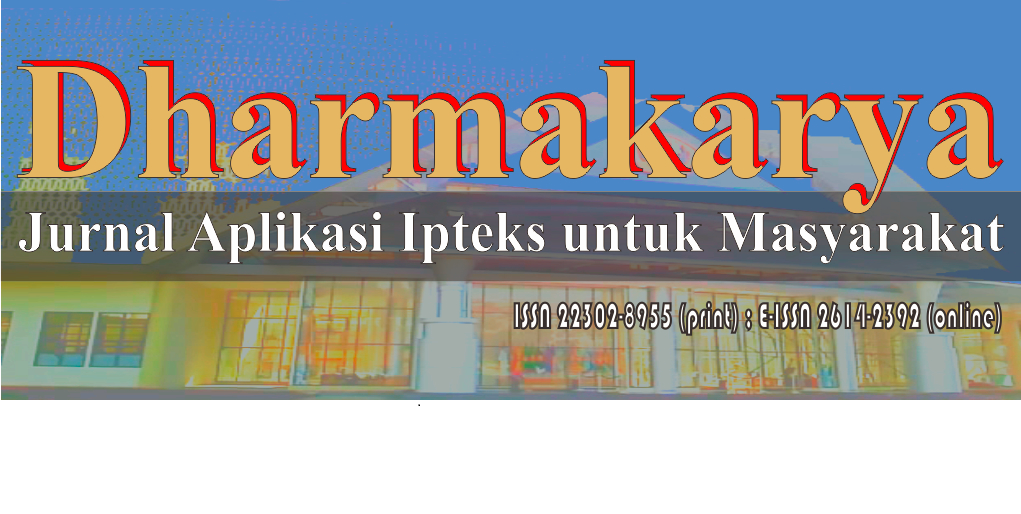PEMANFAATAN EKSTRAK DAUN TIN SEBAGAI SABUN ANTIBAKTERI DAN HAND SANITIZER DI MASA PANDEMI COVID-19
Abstrak
Kata Kunci
Teks Lengkap:
PDFReferensi
Aiello AE, Larson EL, Levy SB. 2007. Consumer Antibacterial Soaps: Effective or Just Risky? Clinical Infectious Diseases. 45(2): S137-47.
Asadi F, Pourkabir M, Maclaren R, Shahriari A. 2006. Alterations to lipid parameters in response to fig tree (Ficus carica) leaf extract in chicken liver slices, Turkish Journal of Veterinary and Animal Sciences. 30(3): 315-318.
Baki G, Alexander KS. 2015. Introduction to Cosmetic Formulation and Technology. John Wiley & Sons. pp. 173.
Bolon MK. 2016. Hand Hygiene: An Update. Infectious Disease Clinics of North America. 30(3): 591-607.
Boyce JM, Pittet D. 2002. Healthcare Infection Control Practices Advisory Committee, HICPAC/SHEA/APIC/IDSA Hand Hygiene Task Force. MMWR. Recommendations and Reports. 51(RR-16): 1-45.
Caliskan O, Polat AA. 2011. Phytochemical and antioxidant properties of selected fig (Ficus carica L.) accessions from the eastern Mediterranean region of Turkey, Scientia Horticulturae, 128(4): 473-478.
Cushnie TPT, Lamb AJ. 2005. Antimicrobial activity of flavonoids. International Journal of Antimicrobial Agents. 26(5): 343-356.
De Amorin A, Borba HR, Carauta PJJ, Lopes D, Kaplan MA. 1999. Anthelmintic activity of the latex of Ficus species. Journal of Ethnopharmacology. 64(3): 255-258.
Duke JA, Bugenschutz-godwin MJ, Du collier J, Duke PK. 2002. Hand Book of Medicinal Herbs, CRCPress, Boca Raton, Fla, USA, 2nd edition.
Gond NY, Khadabadi SS. 2008. Hepatoprotective activity of Ficus carica leaf extract on rifampicin-induced hepatic damage in rats. Indian Journal of Pharmaceutical Sciences. 70(3): 364-366.
Hirose R, Nakaya T, Naito Y, Daidoji T, Bandou R, Inoue K, Dohi O, Yoshida N, Konishi H, Itoh Y. 2019. Situations Leading to Reduced Effectiveness of Current Hand Hygiene against Infectious Mucus from Influenza Virus-Infected patients. mSphere. 4(5).
Jeong KW, Lee JY, Kang DI, Lee JU, Shin SY, Kim Y. 2009. Screening of flavonoids as candidate antibiotics against enterococcus faecalis. Journal of Natural Products. 72(4):719-24.
Jeong MR, Kim HY, Cha JD. 2009. Antimicrobial activity of methanol extract from Ficus carica leaves against oral bacteria, Journal of Bacteriology and Virology. 39(2): 97-102.
Joseph S. Raj J. 2011. Pharmacognostic and phytochemical properties of Ficus carica Linn –An overview. IJPRIF. 3(1): 8-12.
Khameneh B, Iranshahy M, Soheili V, Bazzaz SBF. 2019. Review on plant antimicrobials: a mechanistic viewpoint. Antimicrobial Resistance and Infection Control. 8:118-136.
Oboh IO, Aluyor EO. 2011. A comparative study of a local plant extract as a possible potential medicated agent in the soap industry. Global Journal of Pure and Applied Sciences. 17(3): 345-348.
Oliveira AP, Valentao P, Pereira JA, Silva BM, Tavares F, Andrade PB. 2009. Ficus carica L.: metabolic and biological screening, Food and Chemical Toxicology. 47(11): 2841-2846.
Patil VV, Bhangale SC, Patil RV. 2010. Evaluation of antipyretic potential of Ficus carica leaves, International Journal of Pharmaceutical Sciences Review and Research. 2(2): 48-50.
Penelope O. 1997. Great Natural Remedies, Kyle Cathic Limited, NewYork, NY, USA.
Rubnov S, Kashman Y, Rabinowitz R, Schlesinger M, Mechoulam R. 2001. Suppressors of cancer cell proliferation from fig (Ficus carica) resin: isolation and structure elucidation,” Journal of Natural Products. 64(7): 993-996.
Solomon A, Golubowicz S, Yablowicz Z, et al. 2006. Antioxidant activities and anthocyanin content of fresh fruits of common fig (Ficus carica L.). Journal of Agricultural and Food Chemistry. 54(20): 7717-7723.
DOI: https://doi.org/10.24198/dharmakarya.v13i2.35600
Refbacks
- Saat ini tidak ada refbacks.
##submission.license.cc.by4.footer##
Jurnal Ini Terindeks di:








